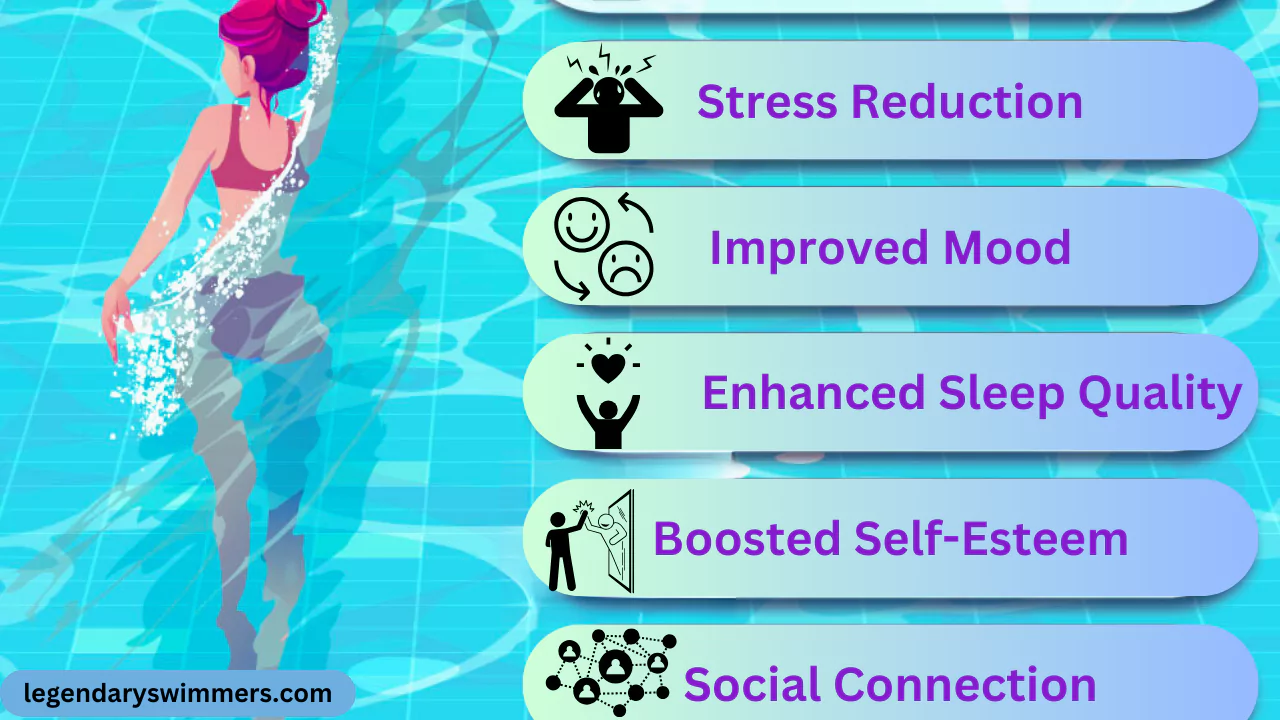
Physical and Mental Health Benefits of Swimming – 2024
- Updated:
By incorporating Swimming into your lifestyle, you can enhance your overall health, reduce stress, improve mood, and experience a higher quality of life. This article delves into the multifaceted benefits of Swimming, exploring its impact on physical health, mental resilience, and overall quality of life.
Physical Benefits of Swimming: A Full-Body Workout
Swimming is a low-impact exercise that engages virtually every muscle group, making it an ideal choice for individuals of all ages and fitness levels.
Cardiovascular Health:
Imagine your heart as a powerful pump. Swimming helps this pump become stronger. When you swim, your heart rate increases, which means it’s working harder to deliver oxygen to your muscles. This regular workout improves your cardiovascular endurance, meaning you can exercise for longer periods without getting tired. Plus, a strong heart reduces your risk of heart diseases like heart attacks and strokes. It’s like giving your heart a regular tune-up!
Muscle Strength and Endurance:
Water resistance is like having a personal trainer. When you push against the water, your muscles work extra hard to move you forward. This builds strength and endurance. Every stroke you take, whether it’s freestyle, backstroke, breaststroke, or butterfly, targets different muscle groups. Your arms, legs, core, and even your back benefit from this full-body workout. Regular swimming can help you sculpt your body and feel stronger.
Joint-Friendly Exercise:
Unlike running or weightlifting, swimming is gentle on your joints. The water supports your body weight, reducing stress on your knees, ankles, and hips. This makes it an excellent choice for people with arthritis or joint pain. If you’ve injured yourself, swimming can be a great way to stay active while your body heals.
Additionally, the water resistance offers a gentle yet effective workout, helping to build strength and endurance without the risk of exacerbating joint issues. Whether you’re performing laps, water aerobics, or simply treading water, you can enjoy the benefits of a full-body workout while minimizing discomfort.
For those recovering from injuries, swimming is a fantastic way to maintain physical activity without putting additional stress on healing tissues. The water’s resistance can aid in rehabilitation by strengthening muscles and improving range of motion, while buoyancy helps to reduce swelling and pain.
Weight Management:
Swimming is more than just a refreshing escape; it’s a powerful tool for weight management. This full-body workout is a calorie-burning powerhouse, helping you shed those extra pounds while enjoying the water’s invigorating embrace.
The water’s resistance provides a unique challenge, engaging your muscles in ways that traditional exercises cannot. As you stroke through the water, you’re not just burning calories but also building lean muscle mass. This increased muscle tone is crucial for weight management as it boosts your metabolism. Think of it as acquiring a personal fat-burning machine!
Unlike high-impact exercises that can strain your joints, swimming offers a low-impact approach to weight loss. This makes it suitable for people of all fitness levels, from beginners to seasoned athletes. Whether you prefer leisurely laps or energetic water aerobics, swimming can be tailored to your preferences and goals.
Remember, sustainable weight management involves a combination of regular exercise and a balanced diet. Swimming can be a cornerstone of your weight loss journey, providing both physical and mental benefits. So, take the plunge and discover the transformative power of swimming for a healthier, happier you.
Improved Flexibility and Balance:
Swimming offers a unique blend of exercise and aquatic therapy that can significantly enhance flexibility and balance. Often described as “yoga in the pool,” swimming utilizes the water’s resistance to gently stretch and elongate muscles. As you glide through the water, you engage muscle groups that might be overlooked in traditional land-based exercises.
Beyond flexibility, swimming is an exceptional workout for balance and coordination. The aquatic environment demands constant adjustments as you navigate through the water. Your body learns to adapt to the changing dynamics, resulting in improved stability and proprioception. Whether you’re performing turns, diving, or simply maintaining your posture, swimming is a full-body workout for balance and agility.
Incorporating swimming into your routine is a holistic approach to enhancing your overall well-being. By combining the benefits of stretching, strength training, and balance exercises, swimming offers a comprehensive workout that leaves you feeling relaxed, rejuvenated, and more flexible.
Skin Health:
Immerse yourself in the world of aquatic beauty as swimming offers a surprising array of benefits for your skin. The gentle pressure of the water acts as a natural cleanser, helping to remove dirt, oil, and impurities from your pores. Regular swimming can contribute to a clearer, more radiant complexion.
However, it’s important to maintain a balanced approach. While chlorine effectively kills germs, excessive exposure can lead to skin dryness and irritation. To maximize the benefits of swimming while protecting your skin, establish a pre- and post-swim routine. A quick shower before your swim removes sweat and makeup, while a rinse-off afterwards helps to remove chlorine residue.
By following these simple steps, you can enjoy the refreshing and rejuvenating effects of swimming on your skin without compromising its health. Remember, moderation is key to maintaining a healthy skin balance.
Mental Health Benefits of Swimming: A Mind-Body Connection

Swimming transcends physical exercise, offering profound benefits for mental well-being.
Stress Reduction:
Swimming can be incredibly calming because it involves rhythmic and repetitive movements, like the steady strokes of your arms and the consistent kicking of your legs. This repetitive nature can make you feel like you’re in a meditative state, almost like when you’re daydreaming or focusing deeply on something. When you’re in the water, it’s easier to let go of the worries and pressures of daily life. The water surrounding you can create a peaceful environment where you can relax and just be in the moment, helping to reduce stress and anxiety.
Improved Mood:
When you swim, your body releases chemicals called endorphins. These are natural “feel-good” chemicals that can make you feel happier and more positive. Swimming regularly can help lift your mood, especially if you’re feeling down or stressed. It can even help with symptoms of depression by giving your mind something positive to focus on, and over time, you may notice an overall improvement in how you feel.
Enhanced Sleep Quality:
Swimming is a great workout that tires your body out in a good way. After a session in the pool, your muscles are relaxed, and your body is ready to rest. This combination of physical activity and relaxation helps you sleep better at night. If you swim regularly, you might find that you fall asleep more easily and stay asleep longer, leading to better overall sleep patterns.
Increased Cognitive Function:
There’s evidence that swimming can make your brain work better. When you swim, more blood flows to your brain, which can help improve memory, focus, and problem-solving skills. It’s like giving your brain a workout along with your body. Regular swimming might help you think more clearly, remember things better, and solve problems more efficiently.
Boosted Self-Esteem:
Setting and achieving goals in swimming, like swimming a certain distance or improving your speed, can make you feel really good about yourself. As you see your progress, like getting stronger or faster, it can give you a sense of accomplishment. This boost in confidence can improve how you see yourself and how you feel about your body.
Social Connection:
Swimming doesn’t have to be a solo activity. It can be a great way to meet people and make friends. Joining a swim class or participating in water aerobics can introduce you to new people who share similar interests. Being part of a group can create a sense of community, where you can encourage each other and build lasting friendships.
Swimming for Specific Populations
Swimming offers advantages for various groups, including:
- Children: Swimming develops essential water safety skills, improves physical fitness, and enhances cognitive development.
- Seniors: Swimming provides low-impact exercise that maintains mobility, flexibility, and strength. It also offers social benefits and reduces the risk of falls.
- Individuals with Disabilities: Swimming can be adapted to accommodate individuals with disabilities, promoting physical activity, independence, and social inclusion.
- Pregnant Women: Swimming offers a safe and enjoyable way to stay active during pregnancy, improving cardiovascular health and reducing discomfort.
Expert Insights
Dr. Sarah Johnson, a renowned sports psychologist, emphasizes the importance of swimming for mental health: “Swimming provides a unique environment for individuals to disconnect from daily stressors and reconnect with their bodies. The rhythmic movements and sensory experiences create a meditative state, promoting relaxation and reducing anxiety.“
Incorporating Swimming into Your Lifestyle
To reap the full benefits of Swimming, consider the following tips:
- Find Your Style: Experiment with different swimming strokes to discover your preferred style.
- Set Realistic Goals: Start with achievable goals and gradually increase intensity and duration.
- Consistency is Key: Regular swimming sessions are essential for experiencing the full range of benefits.
- Safety First: Prioritize water safety by following pool rules and wearing appropriate swim gear.
Swimming Drills for Weight Loss

Swimming offers a multifaceted approach to weight loss, combining calorie burn with muscle toning. The water’s resistance provides a challenging workout, engaging core muscles and promoting overall strength. To maximize weight loss benefits, incorporate these swimming drills into your routine:
- High-Intensity Interval Training (HIIT): Alternate between short bursts of intense Swimming and brief recovery periods. This boosts metabolism and fat burning.
- Water Running: Mimic running movements in the water engage lower body muscles and elevate heart rate.
- Water Aerobics: Combine rhythmic movements with water resistance for a full-body workout that burns calories and improves cardiovascular health.
Benefits of Swimming for Ladies
Swimming is an excellent exercise for women, offering a range of physical and mental health benefits.
- Body Toning: Swimming helps sculpt and tone muscles, creating a leaner physique.
- Improved Posture: The water’s buoyancy supports the body, helping to correct postural imbalances.
- Low-Impact Exercise: Swimming is gentle on joints, making it ideal for women with joint pain or during pregnancy.
- Stress Relief: The calming effects of Swimming can help manage stress and promote relaxation.
- Enhanced Self-Esteem: Achieving swimming goals can boost confidence and body image.
Expert Insights
Dr. Emily Carter, a renowned psychiatrist, emphasizes the connection between Swimming and mental health: “Swimming offers a unique opportunity for individuals to engage in physical activity while simultaneously experiencing a sense of calm and focus. This combination is invaluable for improving mental well-being.“
Swimming: A Prescription for Wellness
Whether you’re seeking physical fitness, mental clarity, or a combination of both, Swimming offers a holistic approach to wellness. By incorporating Swimming into your lifestyle, you can enhance your overall health, boost your mood, and improve your quality of life. So, dive in and experience the transformative power of water!
Safety First
Cold water swimming can be an exhilarating experience, but it’s essential to prioritize safety. Here are some key guidelines to follow:
Acclimatization
Gradually exposing your body to colder water temperatures is crucial. Start with short, controlled sessions and progressively increase your time in the water. This allows your body to adapt and reduce the risk of cold shock.
Proper Gear
Invest in a high-quality wetsuit designed for cold water conditions. Additional layers like a thermal cap and gloves can provide extra warmth. Proper gear helps to maintain your body temperature and prevent hypothermia.
Buddy System
Never swim alone in cold water. A buddy system ensures someone is there to assist in case of emergencies. Swimming in supervised areas with lifeguards on duty is also advisable.
Listen to Your Body
Pay attention to your physical sensations. If you experience shivering, numbness, or difficulty controlling your muscles, it’s time to exit the water immediately. Respect your body’s limits and prioritize safety.
The Social Side of Swimming
Swimming is far more than just a solitary pursuit; it’s a vibrant social activity that fosters connections and camaraderie. Joining a swimming club or participating in group swim sessions offers a unique opportunity to meet like-minded individuals who share a passion for the water.
Sharing experiences, setting goals together, and offering mutual support can create a strong sense of community. Whether you’re a seasoned swimmer or just starting your aquatic journey, the encouragement and motivation derived from fellow swimmers can propel you to new heights.
Enhance your social swimming experience with our range of products designed for comfort and performance. From the supportive Aqua Swim Bar to the stylish Shorty Wetsuit for women, we have everything you need to enjoy your time in the water.
Discover the joy of swimming together. Explore our collection and join the Legendary Swimmers community today!
Conclusion
Whether you’re drawn to the physical challenges, mental benefits, or social aspects of Swimming, taking the plunge into water can be a truly rewarding experience. Remember to prioritize safety and listen to your body as you embark on this invigorating journey.
FAQs:
1. What are the primary benefits of Swimming?
Swimming offers a full-body workout, improves cardiovascular health, builds muscle, enhances flexibility, aids in weight management, and promotes mental well-being.
2. Is swimming a good workout for weight loss?
Yes, Swimming burns calories and helps with weight loss. It combines cardio with muscle toning for effective results.
3. How can Swimming improve mental health?
Swimming reduces stress, anxiety, and depression. It boosts mood, improves sleep, and enhances cognitive function.
4. Is swimming a low-impact exercise?
Yes, Swimming is a low-impact exercise gentle on joints, making it suitable for people with joint pain or injuries.
5. Can swimming help with joint pain?
Swimming can alleviate joint pain by reducing stress on joints and improving flexibility.
6. How often should I swim to see results?
Consistency is key. Aim for at least 3 sessions per week to start, gradually increasing frequency and duration.
7. How does Swimming improve cardiovascular health?
Swimming elevates heart rate, strengthens the heart, improves lung capacity, and reduces the risk of heart disease.
8. Does Swimming build muscle?
Yes, Swimming builds muscle through water resistance. Focus on different strokes to target various muscle groups.
9. Can swimming help with flexibility and balance?
Absolutely, Swimming improves flexibility, range of motion, and body coordination, enhancing balance.
10. How can Swimming improve sleep quality?
Swimming helps regulate sleep patterns by combining physical exertion with relaxation, leading to better sleep
References:

Natasha Nicole Leyva
Hi, I’m Natasha—swimmer, coach, and aquatic fitness enthusiast. My journey began in New Zealand after a professor recommended swimming to help with a knee injury. The low-impact nature of swimming worked wonders, and it quickly became my favorite form of exercise. This passion grew into a thriving swim academy, and soon, requests for aquatic fitness classes started pouring in. After becoming certified, I realized how powerful water workouts could be for recovery and fitness. Now, I share my expertise here to help others experience the benefits of aquatic movement—whether for recovery, fitness, or fun!






